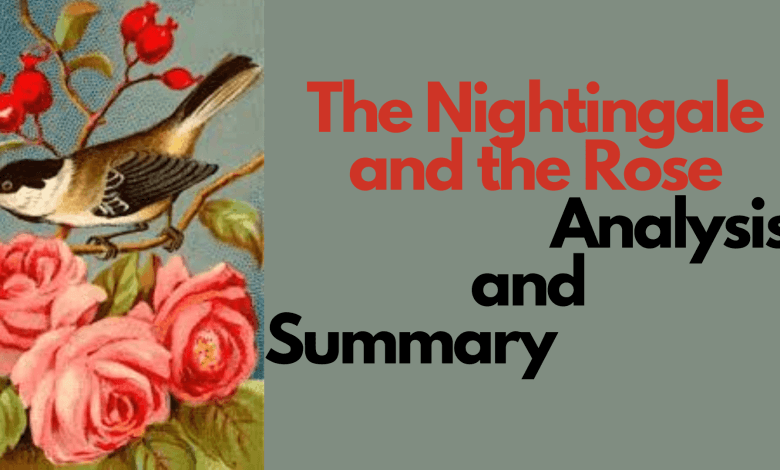
The Nightingale and the Rose is a romantic short story which involves the struggle of a lover boy and the sacrifice of a nightingale for that boy. The Analysis and a full summary of the Nightingale and the Rose is done her on this page.
AUTHOR’S INTRODUCTION
Oscar Wilde was an Irish poet, and dramatist whose reputation rests on his only novel, The Picture of Dorian Gray (1891), and on his comic masterpieces Lady Windermere’s Fan (1892) and The Importance of Being Earnest (1895).He has also written short stories as well.
Oscar was a member of prominent family. During his studies at OXFORD he gained fame as poet, scholar and as spokesman for Aesthetic movement in England. The main purpose of this movement to develop art as beauty, Art for art’s sake. The Nightingale and Rose was published in 1888.
Twilight in Delhi Themes, Characters and Summary
The Nightingale and the Rose SUMMARY
Many of Wilde’s fairy tales are about characters sacrificing themselves. ‘The Nightingale and the Rose’ is a tragic fairy tale for children by Oscar Wilde (1854-1900), included in his 1888 collection The Happy Prince and Other Tales. ‘The Nightingale and the Rose’ is about romantic love.
In this short story nightingale sacrifices herself for a student who fell in love with teacher’s daughter. A ball is to be held by the Prince. She promises to dance with him at ball.
She asks him that she will dance with him if brings red rose for her but unfortunately student’s garden has no red rose. He begins to cry.
The Nightingale listens to him crying and decides to help him because she has seen his true love for girl.
A lizard, a butterfly and a Daisy all tell the Nightingale that it is useless to cry for red rose but she sympathizes with him.
She goes to Rose tree and asks to produce red rose, and in return she will sing for it.But Rose tree says that is produces only white roses. It asks to go towards Rose-tree by the sun dial.
The Nightingale offers same to it but it says that it only produces only yellow roses, so it cannot help her. However, it suggests to the Rose-tree right under the window of student. But it was frozen due to winter and does not produce roses.
The Nightingale asks if there is any possibility to get a rose for students. The tree replies there is only one way of producing roses. The Nightingale is supposed to sing by moonlight while allowing a thorn to pierce her heart, so her blood seeps through to the tree and produces a red rose.
Nightingale agrees to this, because for her love is more valuable than life, and a human heart is more precious than hers.
She goes and tells him that she is going to do this but he does not understand, because he only understands things written down in books. Only Oak-tree understands her words.
She sings, but the Student is rather unimpressed because the bird’s song has no practical use.
That night, the Nightingale sings with her heart against the thorn, until it eventually pierces her heart. Her heart’s blood seeps into the tree and produces a red rose, but by the time the flower is formed, the Nightingale has died.

Our Lady of Alice Bhatti By M Hanif Summary and IMP Themes
The Nightingale and the Rose ANALYSIS
The Nightingale is short story about true love that is rare. She is true worshiper of love but boy and girl do not know the worth of love.
The Nightingale sacrifices herself for the sake of true love as she knows the worth of love. But, her sacrifice does not achieve its purpose and professor’s daughter rejects his flower and love.
Through this idea, Wilde wants to give an idea about materialistic world that has no notion for emotions and true love. Most of Wilde’s fairy tales are about characters sacrifice.
The Nightingale is about Nightingale’s sacrifice. She thinks that it is worth-dying for the sake of true love and pierces her heart against a spike to transfer her heart’s blood to stain a rose with red color.
It’s all about art and nature. The rose is beautiful and wonderful work of art which grows rose by the fusion of the Nightingale’s song that is known for its beautiful and melodious voice.The sacrifice of Nightingale is not useless rather it produced a work of art.
The sacrifice of the Nightingale goes wasted and is not appreciated by anyone except the red rose-tree who knew about the seriousness of her intended sacrifice.
It also shows that the sacrifices made for others are not given importance rather material pursuits are more important for people.
But, it shows the selfish nature of people. The red rose is a symbol of true love. The Nightingale stains the rose with her own blood which shows the value of true love and self-sacrifice.
When the student sees the rose under his window, he plucks it for the girl without thinking for its life once. It shows the materialistic and selfish nature of people and how shallow they are from inside.
The Nightingale is embodiment of this caprice as she has put herself for the sake of art. Modern age is practical to appreciate art for art sake that was slogan of Aestheticism, a movement for which Wilde was prominent spokesperson.
‘The Nightingale and the Rose’ contains many features of traditional fairy tales, a lover (student), beloved (professor’s daughter), a helper (the Nightingale).
Wilde has shown these common characters to show the unromantic and materialistic nature of student as well as beloved.
The hero is known for sacrifice to get his love. Sometimes, they give special gift but usually this happens to impress girl’s father as Aladdin has to convince Sultan.
But, in this short story he has to convince girl rather than the father, who rejects his precious gift when she has materialistic presents.
Nawabdin Electrician Summary and Analysis by Daniyal Mueenuddin
THE NIGHTINGALE AND THE ROSE CHARACTERS ANALYSIS
THE NIGHTINGALE:
The Nightingale is the protagonist of the story. The Nightingale is a bird who lives in oak tree. She admires beauty and love and is willing to die for their sake. She is romantic by nature and is inspired by student’s love.
She sings about love all the time and waits to see it. When she sees the student crying for a red rose, she decides to sacrifice her life to help him out. She sings for him and succeeds in getting red-rose;
“Night after night have I sung of him, though I knew him not: night after night have I told his story to the stars, and now I see him? His hair is dark as the hyacinth-blossom, and his lips are red as the rose of his desire; but passion has made his lace like pale Ivory, and sorrow has set her seal upon his brow.”
She gives her heart’s blood to a white flower to color red rose for the help of student and dies.
‘Be happy,’ cried the Nightingale, ‘be happy; you shall have your red rose. I will build it out of music by moonlight, and stain it with my own heart’s-blood. All that I ask of you in return is that you will be a true lover, for Love is wiser than Philosophy, though she is wise, and mightier than Power, though he is mighty.
The whole story revolves around her sacrifice and selfless nature which is not appreciated throughout the story. This is dilemma of modern age that art is not appreciated as like in this story.
At the end of the story, her sacrifice is ignored and wasted by everyone when the red rose is rejected and thrown in gutter by student.
Her selfless nature shows that true love exist but people does not appreciate it.
THE STUDENT:
He is a young boy with beautiful eyes and red lips who claims is in love with a girl. In the very beginning of the story the student appears to be a true lover who cries in his garden for the sake of red rose that was guarantee of his love- life.
The professor’s daughter asks him to present her red rose;
“She said that she would dance with me if I brought her red roses,’ cried the young Student; ‘but in all my garden there is no red rose.”
His lamentation inspires the Nightingale to sacrifice her life to help him. The Nightingale decides to help him as she values love and says;
“Here at last is a true lover,’ said the Nightingale”.
His true nature is revealed at the end of story that sows that he is not practical and his thoughts lacks realistic approach.
When the girls reject the red rose given by him, suddenly all his love fades away. He decides that love is unpractical. It shows him as a materialistic person rather than a person who believes in love and selflessness.
He does not appreciate Nightingale’s sacrifice and does not fulfill her last wish that was to be true to his love.
“All that I ask of you in return is that you will be a true lover.”
THE GIRL:
The girl is briefly introduced in the story. She expresses an important theme. She is the student’s sweetheart and professor’s daughter. She tells the student to bring a red rose for her if he wants to dance with her in the party
She said that she would dance with me if I brought her red roses,’ cried the young Student; ‘but in all my garden there is no red rose.
When the student brings her a bright red-rose she rejects it because she is provided with jewels by another rich suitor.
The Chamberlain’s nephew has sent me some real jewels, and everybody knows that jewels cost far more than flowers.
This act of selfishness shows her as a materialistic nature who values wealth more than true love.
THE YELLOW ROSE-TREE:
This is a minor character and the second tree the Nightingale visits in search of a red rose. He also does not have one so he suggests her to go to another tree, the red rose-tree, to seek help from.
THE LIZARD:
This character appears in the beginning of the story. When the student cries, he overhears him and laughs at him because he finds it useless to cry for a red rose.
‘Why is he weeping?’ asked a little Green Lizard, as he ran past him with his tail in the air
‘He is weeping for a red rose,’ said the Nightingale.
For a red rose!’ they cried; ‘how very ridiculous!’ and the little Lizard, who was something of a cynic, laughed outright.
It shows the lizard as a pessimist who believes that people are motivated by self-interest rather than acting for selfless reasons.
This belief of lizard can be seen in the end of the story when the rose, a symbol of sacrificial love, is rejected by the girl and destroyed by the student for their self-interests.
THE OAK-TREE:
The Oak-tree is the minor character of the story. This is the tree where the Nightingale resides. He knows about the seriousness of Nightingale’s decision of sacrificing her life and begs her to sing a last song for him.
THE WHITE ROSE-TREE:
The Red-rose tree is a minor character of the story. When the Nightingale goes in the search of a red rose, she asks the white rose-tree to help her but he does not have any red rose so he suggests her to go to another tree to seek help from.
‘Give me a red rose,’ she cried, ‘and I will sing you my sweetest song. ‘But the Tree shook its head.
‘My roses are white,’ it answered; ‘as white as the foam of the sea, and whiter than the snow upon the mountain. But go to my brother who grows round the old sun-dial, and perhaps he will give you what you want.’
THE ROSE TREE:
There are three rose trees in the story but only one plays a major role in it. This is the tree under student’s window that helps the Nightingale in creating a red rose.
When Nightingale asks him for a way of getting a red rose, he refuses to tell her because he does not want her to lose her life. On the insistence of Nightingale it tells her;
‘If you want a red rose,’ said the Tree, ‘you must build it out of music by moonlight, and stain it with your own heart’s-blood. You must sing to me with your breast against a thorn. All night long you must sing to me, and the thorn must pierce your heart, and your life-blood must flow into my veins, and become mine.
The Nightingale does the same as tree asks her. The rose-tree is the only one in the story who recognizes her sacrifice and remains sympathetic her.
Burnt Shadows Summary, Characters and Main Themes
The Nightingale and the Rose THEMES
“The Nightingale and the Rose “contains a lot of wonderful and philosophical themes. Such as;
- Ironic theme of love
- Importance of love
- Emotion
- Sacrifice
- Art and idealism
- Worth of Beauty
- Materialism
- Power of philosophy
Importance of Love:
Love is always there in this short story as in the beginning of this story readers meet a student who was crying for the sake of love. He wants to dance with her but she demands red rose that was nowhere in his garden.
But, the true admirer of love the Nightingale feels sympathy for him as she finds true love in his cry. The Nightingale is one who knows the importance of love and decides to take risk of her heart for the sake of saving men heart. The production of red rose in autumn is a miracle and this miracle was done by the Nightingale.
The student does nothing to get his love but at the same time he enthusiastically wants the girl. He accepts his defeat before trial. It was the Nightingale who does everything.
Through this idea, Wilde throws light on the importance of love. He gives it’s example by humans as well as nature.
In order to define love, the nightingale says:
“Surely Love is a wonderful thing. It is more precious than emeralds, and dearer than fine opals. Pearls and pomegranates cannot buy it, nor is it set forth in the market-place. It may not be purchased of the merchants, ‘or can it be weighed out in the balance for gold.’ (Oscar Wilde)
Ironic theme of love
In this short story the theme of love is ironic as in the start of the story the boy was ambitious to get his in the end of this story the love is purchased and unsatisfied.
Nightingale tells about the human emotions.it is emotion that is difficult to suppress. Because one can differentiate people through suppression of emotions.
But the student that claims to be in love with professor’s daughter become coward. And also girl measure through the lens of wealth and prefers to jewel and pearls.
But at the same time the love of the Nightingale seems opposite to reality. She does that was impossible for boy, but her sacrifice was destroyed. That’s way there is irony in love.
Emotion:
Love is an unending and everlasting emotion. The Nightingale is in favor of this emotion. Her act encourages readers to think about this emotion.
That’s the way she sings the song of love for centuries. She knows the power of this emotion and sacrifices herself for this emotion because for this emotion people came to fight and face to face in the battlefield.
The writer also expresses this fact in his short story when he writes:
“Night after night have I told his story to the stars, and now I see him.”
The Nightingale’s song urge people that love is an unending human emotion. There are two types of characters that claim to have love.
Some of them are unknown to this emotion as lizards.
‘For a red rose!’ they cried; ‘how very ridiculous!’ and the little Lizard, who was something of a cynic, laughed outright.
When Nightingale tells about the passion of boy, lizard laughs because lizard does not understands the significance of love.
Similarly, the boy knows the importance but girl does not. The writer has put a juxtaposition between known and unknown to make a comparison between the two for better understanding.
SACRIFICE AND SELFLESSNESS
Where there is love there is sacrifice. But, in this story boy does not sacrifice anything but his love is suppressed when girl threw the rose as well as his love.
Likewise, the Nightingale sacrifices for red rose. She wants flower not for herself but for boy and cries to get any way to get red rose.
When rose tree tells her possibility to get flower, she without thinking further dies for the rise. It is also the main idea of this short story that some people sacrifice to make their lives better but there are those who do so for the sake of others.
Wilde has given the idea about modern age that in this time sacrifice goes waste likewise the Nightingale does not get the reward of her efforts.
Nightingale does not get anything in return but she gives her blood to give the boy a red rose. Her (nightingales) philosophy was to help others. On the surface sacrifice seems like a waste but in reality it is not.
Materialism
Materialism is an important theme of this short story,
When he finds the red rose, he goes to the girl and tells her that he has done the impossible. On seeing the red rose, the girl says:
“The Chamberlain’s nephew has sent me some real jewels, and everybody knows that jewels cost far more than flowers.”
She further argues:
“I don’t believe you have even got silver buckles to your shoes as the Chamberlain’s nephew has”
These two dialogues show that for her luxuries mean more than love.
The boy feels at the end that love is nothing but a waste of intellectuality and time ad throw rose in gutter.
Materialism prevails love at the end of the story gives massage that it is much easier to purchase love nowadays.
Power of Philosophy
Philosophy makes a person intellectual by which he can get respect, earn money and can become a powerful person.
Oscar Wilde portrays two separate themes in “The Nightingale and the Rose” side by side; one is the importance of love whereas the second is the power of philosophy. At the start the boy utters:
“I have read all that the wise men have written, and all the secrets of philosophy are mine, yet for want of a red rose is my life made wretched”.
Similarly, on another occasion, the writer compares philosophy with love. He writes:
“Love is wiser than Philosophy, though she is wise, and mightier than Power”.
In fact, the writer focuses that philosophy is wiser than love; those who are wiser are also stronger and more powerful.
The boy refuses to sacrifice and waste his energy in love and chooses philosophy at the end. The writer concludes:
“I [the boy] shall go back to Philosophy and study Metaphysics.”
The writer emphasizes love as a strong desire but at the same time he paints the strength of intellectuality as well as philosophy as two prominent themes of “The Nightingale and the Rose.”
Ode: Intimations of Immortality Summary (Line by Line) +PPT
The Nightingale and the Rose Other Details
LITERARY PERIOD:
Aestheticism
GENRE:
Fairy tale, short story, satire
SETTING:
A garden was the setting of this short story.
NOTE: This Post is written by “Ms. Yameena Yar Gondal”…



